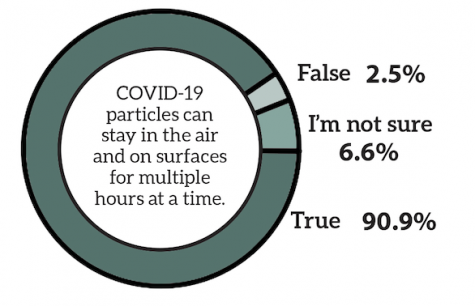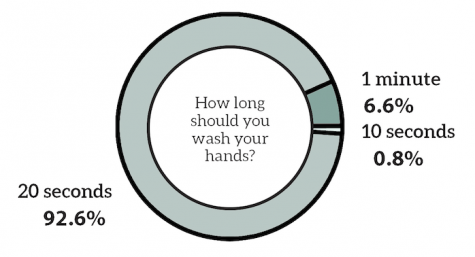Special Report: Survey Reveals Fordham Students’ Knowledge of the Coronavirus
A survey conducted at FCLC asked students understandings and perceptions about the coronavirus pandemic.
April 15, 2020
For a week in April, The Observer circulated an anonymous survey to 121 Fordham College at Lincoln Center students to gauge the student body’s understanding of the facts and myths surrounding the outbreak of COVID-19, the disease caused by the coronavirus. Out of the respondents, 103 students expressed that they were concerned about the virus.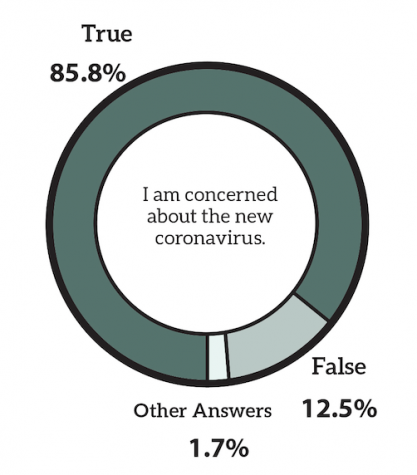
The first case of coronavirus in the U.S. was reported on Jan. 21 in Washington state and began spreading rapidly throughout the country. As of April 13, there are currently 547,627 confirmed cases and 21,662 deaths in the U.S.
The rampant spread of the virus forced the U.S. government to declare a state of emergency on March 13. Additional measures to try to slow the curve of the virus have been implemented throughout March and April. On March 26, the U.S. surpassed China and Italy to become the most infected country in the world.
In response to these dramatic changes to daily life, 66% of students stated they read or watched the latest news regarding the COVID-19 outbreak daily and 25.6% of students said they caught up on the news a few times a day. 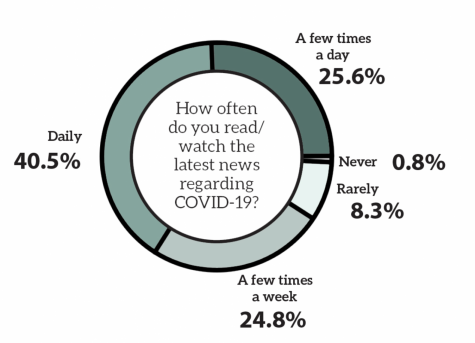
Symptoms of the coronavirus include fever, cough and difficulty breathing. Generally, exposed individuals present with these symptoms within two to 14 days.
COVID-19 is a respiratory disease that invades the lungs in sequential steps. Initially, the virus enters lung cells and injects its genetic material into them. The original host cells then replicate the viral particles and release them into the body. During this stage, airways in the lungs can be inundated with liquids and debris which can lead to pneumonia and/or shortness of breath.
Out of the responses collected, 44.6% of students believed that they would not get pneumonia if they contracted COVID-19, while 18% cited it as a possible consequence of the illness.
After infecting the lungs, the coronavirus can enter a second stage dubbed “immune hyper-reactivity.” Viral intrusion triggers the immune system to release antibodies to fight off the disease. Sometimes, however, these immune cells begin to injure healthy tissue as well. Unregulated immune cells could set off the last stage, “pulmonary destruction.” During this step, lung damage is exacerbated and can potentially lead to respiratory failure.
When asked if losing one’s sense of smell or taste was a symptom of COVID-19, 75.2% of respondents said it was. However, studies have found losing these senses could be a possible symptom of the virus, but not a key symptom. There is not enough evidence to suggest that the presence of these symptoms suggest that someone has the virus.
The Centers for Disease Control and Prevention (CDC) recommends a 14-day quarantine period for individuals exposed to the coronavirus to minimize spreading. The virus has a median incubation period of five days, which means the two-week observation period is sufficient time to track the progress of infected patients.
California became the first state to announce a shelter-in-place order on March 19. Other states — such as New York — issued stay-at-home orders in the following weeks, extending until May to try and slow the spread of the virus.
The most common way COVID-19 spreads is when an infected person coughs or sneezes and exposes another person to their respiratory droplets. The new coronavirus can remain in the air for up to 3 hours. If individuals are within 6 feet of each other, there is a higher chance the virus will spread.
People can also contract the virus if they touch an infected surface and then touch their faces. 90.1% of students knew that the new coronavirus can live on surfaces for several hours, though 6.6% of respondents said they were not sure how long it stays viable on surfaces.
One study found that the virus can remain on plastics for 72 hours, on stainless steel for 48 hours, on cardboard for 24 hours and on copper for 4 hours.
Additionally, preliminary studies have suggested that the virus can spread no matter what temperature it is. The Observer’s survey revealed that 11.6% of students were not sure if they could contract the virus when the weather is warmer, and 2.5% of respondents thought they could not catch the novel coronavirus if the temperature was higher.
The Mayo Clinic has confirmed that the severity of COVID-19 increases with age or in the presence of preexisting health conditions that render individuals immunocompromised. While anyone can be affected by the virus, many believe that young people are not at risk.
Of the students who took the survey, 99.2% believed that young people can be affected by the novel coronavirus, but when asked if they felt personally at risk, 41.3% of students said that they do not feel like they are at risk for COVID-19.
One student said, “Just because you as a young person are at a theoretical lower risk than other age groups doesn’t mean you won’t accidentally spread it to people who are higher risk, thus endangering them and potentially causing their death.”
The CDC has recommended a variety of different preventive measures that people should take to avoid catching and spreading the virus.
One measure is wearing homemade cloth face coverings when going to densely populated areas. The survey data found that 53.3% of students believed they should always wear a mask when they go outdoors. 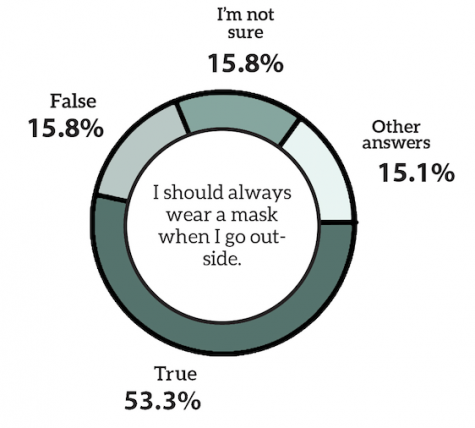
One student wrote, “To my knowledge, if you go to a decently populated place (grocery store) the CDC said we should, but im not sure about just going on a walk or something.”
Experts say that it is relatively safe to exercise outside with or without a mask, but it is still recommended to cover your face with a cloth that minimizes the wetness masks can accumulate when exercising.
Other preventative measures include washing your hands and using hand sanitizer. The CDC recommends washing your hands for 20 seconds, which 92.6% of students were aware of, though 6.6% of students thought you should wash your hands for one minute.
Additionally, 10% of students believed that all hand sanitizers could effectively combat germs, while 10% of students were unsure of the efficacy of all sanitizing agents. Studies have shown that hand sanitizers with higher alcohol concentrations were more effective in killing germs. It is recommended to use sanitizers with 60-95% alcohol content. However, the CDC reported that washing your hands is more effective than using hand sanitizers.
There are some rumors regarding the new coronavirus that suggest certain home remedies can protect against contracting the coronavirus. These remedies include: herbal teas, garlic, essential oils, vitamin C, burning sage, silver colloid, saline solution, chlorine and hot baths.
When asked whether home remedies will protect against contracting COVID-19, the majority of students believed that they will not protect them from becoming infected.
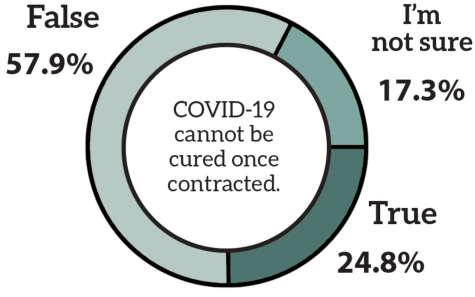 Of the 121 responses, six students mentioned that isolation, regular doses of vitamins and minerals, and the disinfecting of surfaces were ways to protect against getting COVID-19, but qualified their response by stating none of these are 100% effective.
Of the 121 responses, six students mentioned that isolation, regular doses of vitamins and minerals, and the disinfecting of surfaces were ways to protect against getting COVID-19, but qualified their response by stating none of these are 100% effective.
According to the U.S. Department of Health and Human Services (HHS), there is no scientific evidence that any alternative remedies will prevent or cure the illness caused by the virus. “The best way to prevent infection is to avoid exposure to this virus,” the HHS reported.
Additionally, antibiotics treat bacterial infections, not viral ones. When asked if antibiotics could treat COVID-19, 82.6% of students said they could not.
Update April 16, 2020: An earlier version of this article incorrectly stated that antibodies could “bolster” one’s immune system. Antibodies are produced by the immune system to combat bacteria, viruses, and foreign substances in the blood. They are not made as supplements. This article was edited to reflect these details.


